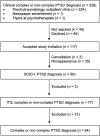Characterization of cognitive functioning in complex PTSD compared to non-complex PTSD
- PMID: 39882167
- PMCID: PMC11775631
- DOI: 10.3389/fpsyt.2024.1433614
Characterization of cognitive functioning in complex PTSD compared to non-complex PTSD
Abstract
Background: Previous research has indicated cognitive impairments in patients with post-traumatic stress disorder (PTSD), specifically in attention, memory, and executive functioning. However, there is limited knowledge about the cognitive profile of individuals with complex PTSD (cPTSD), a new diagnosis in ICD-11. Moreover, predictors of cognitive impairment remain unclear. The present study aims to enhance understanding of cognitive functioning and its predictors in cPTSD compared with non-complex PTSD (ncPTSD).
Methods: N = 64 participants (n = 34 cPTSD, n = 30 ncPTSD) completed psychometric questionnaires and the neuropsychological test set Cognitive Basic Assessment (COGBAT) assessing a general cognitive index, attention, visual memory, and executive functioning. First, the test results of both groups were compared to the COGBAT norm sample. Secondly, group differences in cognitive domains were analyzed using student t-tests with independent samples (cPTSD vs. ncPTSD). Thirdly, bivariate and multivariate regressions examined influencing factors of cognitive impairment.
Results: Both groups showed cognitive impairments in comparison to the COGBAT norm group. Significant differences between cPTSD and ncPTSD were found in visual memory (p = .003) and selective attention (p = .004). In multivariate regression, type of PTSD and age were found to significantly impact visual memory, while type of PTSD, age, and psychotropic medication showed significant effects on selective attention.
Conclusions: Given higher symptom severity and cognitive deficits in cPTSD, more intensive and diverse interventions should be considered in comprehensive treatment plans, for instance, cognitive training.
Keywords: attention; cognitive functioning; complex PTSD; executive functioning; visual memory.
Copyright © 2025 Schöndorf, Terhoeven, Jaehn, Roesch-Ely, Friederich, Nikendei and Kindermann.
Conflict of interest statement
The authors declare that the research was conducted in the absence of any commercial or financial relationships that could be construed as a potential conflict of interest.
Figures
References
-
- World Health Organization . International Statistical Classification of Diseases and Related Health Problems. 11th ed. Geneva: World Health Organization; (2018). Available at: https://icd.who.int/en.
-
- American Psychiatric Association . Diagnostic and statistical Manual of Mental Disorders. Fifth Edition. American Psychiatric Association; (2013).
LinkOut - more resources
Full Text Sources


